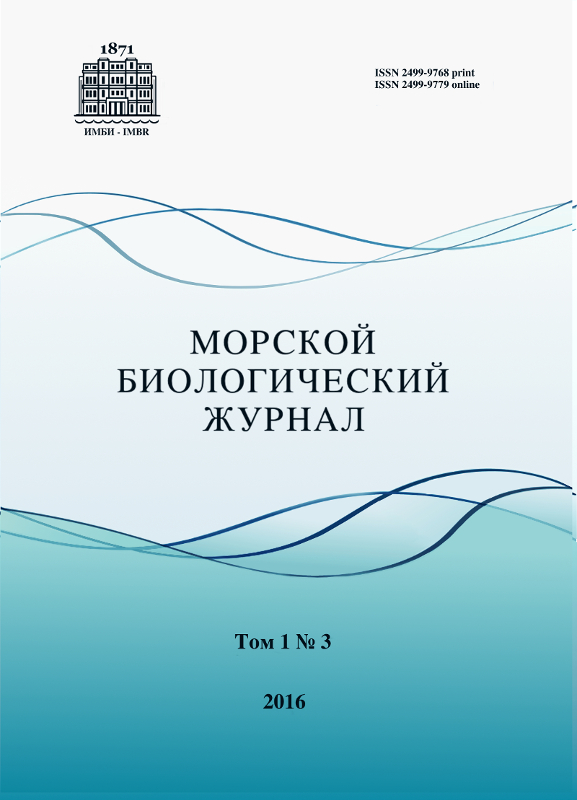Plankton and benthic community of highly mineralized rivers in the basin of Lake Elton: statistical analysis of correlations
##plugins.themes.ibsscustom.article.main##
##plugins.themes.ibsscustom.article.details##
Abstract
A comparative analysis of changes in taxonomic structure of communities of benthic and plankton organisms formed under extreme environmental factors on the example of an ecosystem of highly mineralized rivers in the basin of hyper-saline Lake Elton, located 49°13 ́ N 46°40 ́ E was carried out. It is shown that under the influence of sudden climatic fluctuations a hydro-ecosystem is not functioning in the evolutionary stacked stationary mode, but there is a constant rearrangement of taxonomic structure of its constituent communities. For multivariate statistical analysis we have used long-term data of hydrobiological survey of macrozoobenthos, zooplankton and meiobenthos at 15 stations, 5 saline rivers of different levels of mineralization, as well as the corresponding block of 19 abiotic indicators. We have tested various hypotheses about the causes and patterns of change in the species structure of the studied communities in conditions of extreme factors (level of salinity, temperature, and eutrophication). It was found out that the structures of plankton and benthic communities are correlating reasonably well, indicating a close relationship between them. This relationship is determined by a mutually agreed reaction on the changes of the aquatic environment factors and biotic interactions, and it explains the decrease of the matrix correlation Mantel coefficients between aquatic complexes and hydro-chemical indicators. The usage of the methods of cluster analysis helped to carry out a taxonomic identification of the coenoses of plankton and benthic communities, that develop in similar habitats in terms of overlapping ecological niches. A targeted graphical projection of taxa of the studied communities and aquatic sampling sites in the space environment factors was carried out on the bases of the canonical multivariate ordination methods. We determined the role of each abiotic indicator to characterize the features of macrozoobenthos populations, meiobenthos, and zooplankton. A comparative analysis of changes in the species diversity of communities using the generalized Renyi entropy was carried out. The interaction of plankton and benthic communities in saline rivers revealed a high share of the genesis of composition ”interpenetrating” environmental groups.
Authors
References
Ануфриева Е. В., Шадрин Н. В. Разнообразие ракообразных в гиперсолёном озере Херсонесское (Крым) // Экосистемы, их оптимизация и охрана. 2012. Вып. 7. С. 55–61. [Anufrieva E. V., Shadrin N. V. Crustacean diversity in hypersaline Chersoness Lake (Crimea). Ekosistemy, ikh optimizatsiya i okhrana, 2012, iss. 7, pp. 55–61. (in Russ.)].
Кривошеина М.Г. Морфологические и экологические механизмы устойчивости гидробионтных личинок двукрылых (Insecta, Diptera) к экстремальным условиям : дис. ... д-ра биол. наук. Москва, 2004. 314 л. [Krivosheina M. G. Morfologicheskie i ekologicheskie mekhanizmy ustoichivosti gidrobiontnykh lichinok dvukrylykh (Insecta, Diptera) k ekstremal’nym usloviyam: diss. ... d-ra biol. nauk. Moscow, 2004, 314 p. (in Russ.)].
Хлебович В. В. Акклимация животных организмов. Ленинград : Наука, 1981. 135 с. [Khlebovich V. V. Akklimatsiya zhivotnykh organizmov. Leningrad: Nauka, 1981, 135 p.].
Ubertini M., Lefebvre S., Gangnery A., Grangere ́ K., Le Gendre R., Orvain F. Spatial variability of benthic-pelagic coupling in an estuary ecosystem: consequences for microphytobenthos resuspension phenomenon. PLoS ONE, 2012, vol. 7, no. 8, e44155. doi:10.1371/journal.pone.004415.


 Google Scholar
Google Scholar



